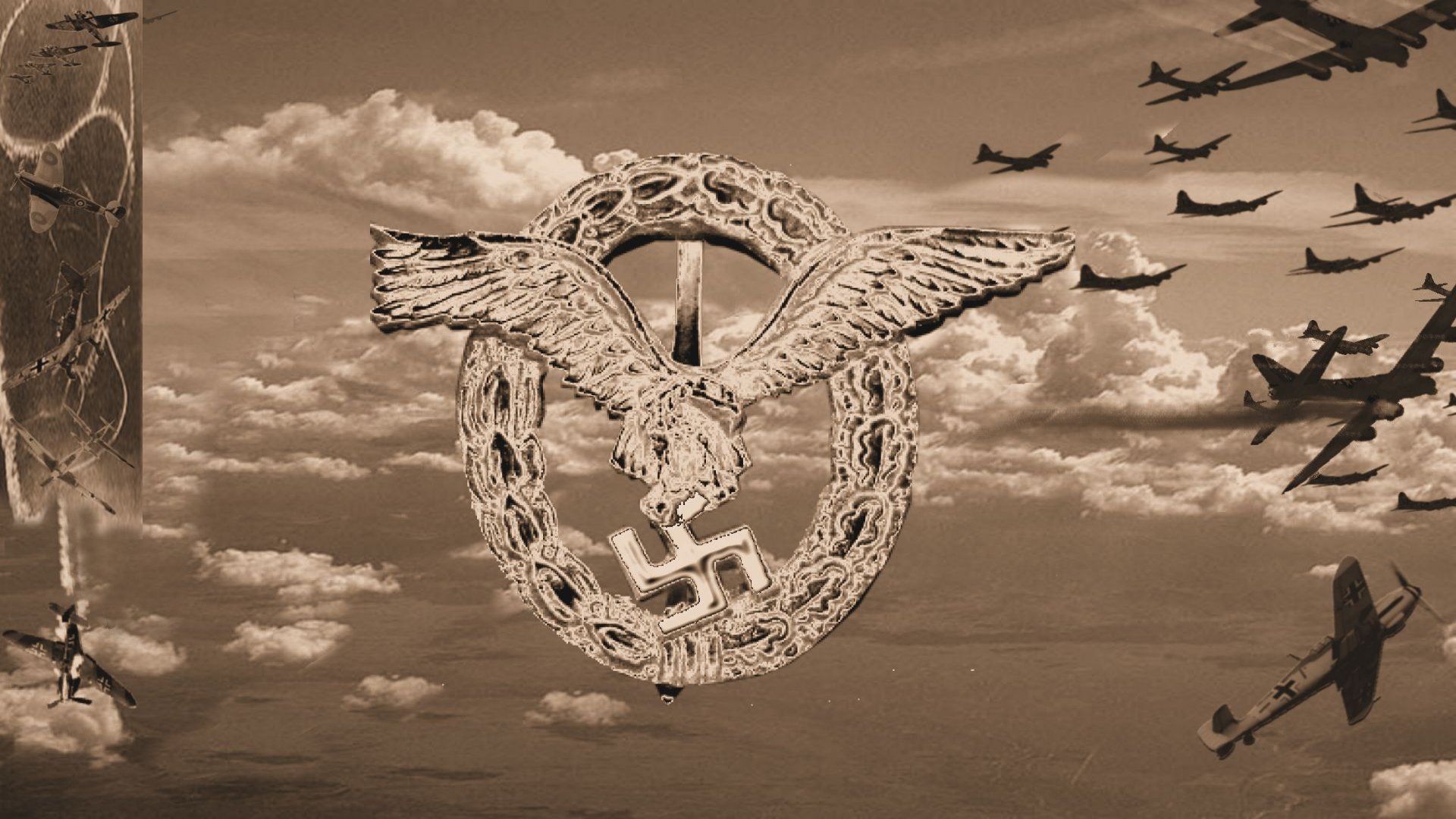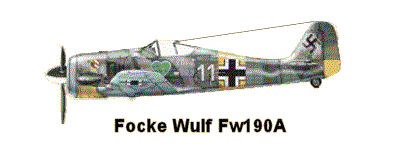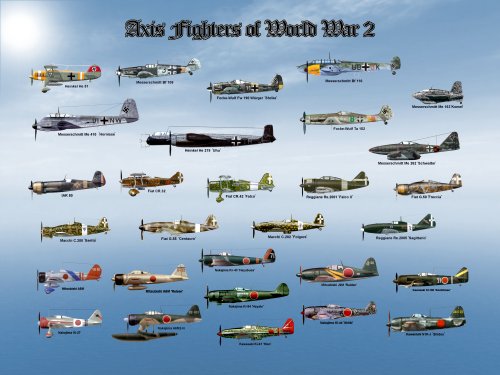The Focke-Wulf Fw 190 'Würger' was a German single-seat, single-engine fighter aircraft designed by Kurt Tank in the late 1930s and widely used during World War II. Along with its well-known counterpart, the Messerschmitt Bf 109, the Fw 190 became the backbone of the Luftwaffe's Jagdwaffe (Fighter Force).
Development
In the autumn of 1937 the German Air Ministry decided it needed another fighter aircraft to supplement the Messerschmitt Bf 109. The design team was headed by Kurt Tank, the technical director of Focke Wulf Flugzeugbau. At the time, the use of radial engines in land-based fighters was relatively rare in Europe, as it was believed that their large frontal area would cause too much drag on something as small as a fighter. Tank was not convinced of this, having witnessed the successful use of radial engines by the U.S. Navy, and felt a properly streamlined installation would eliminate this problem. Tank introduced a further refinement to this basic concept. He suggested placing most of the airflow components on the propeller, in the form of a oversized propeller spinner whose outside diameter was the same as the engine. The cowl around the engine proper was greatly simplified, essentially a basic cylinder. Air entered through a small hole at the centre of the propeller, and was directed through ductwork in the spinner so it was blowing rearward along the cylinder heads. To provide enough airflow, a cone was placed in the centre of the hole, over the propeller hub, which was intended to compress the airflow and allow a smaller opening to be used. For the canopy design, Tank's new design included a canopy that used only a single perimeter frame, with only a single short centerline seam frame forward of the radio antenna fitting atop the canopy's highest point, where the three-panel windscreen and forward edge of the canopy met, just in front of the pilot. The creation was the Fw190 Würger (English: Shrike, also known as the 'Butcher Bird') which flew for the first time on 1st June, 1939, but the aircraft was redesigned to take advantage of a new and more powerful BMW engine and technical problems meant that it did not become fully operational until July, 1941. The pre-production Fw 190 A-0 series was ordered in November 1940, a total of 28 being completed. Because they were built before the new wing design was fully tested and approved, the first nine A-0s were fitted with the original small wings. All were armed with six 7.92 mm (.312 in) MG 17 machine guns:- four synchronised weapons, two in the forward fuselage and one in each wing root, supplemented by a free-firing MG 17 in each wing, outboard of the propeller disc. The Fw 190 A-1 rolled off the assembly lines in June 1941. The first few models were shipped to the 'Erprobungsstaffel' (formerly from II./JG 26 'Schlageter') for further testing. Following this testing, the Fw 190 A-1 entered service with II./JG 26, stationed near Paris, France.
Back to Top
Main Variants
The A-1 was equipped with the BMW 801 C-1 engine, rated at 1,560 PS (1,539 hp, 1,147 kW) for take-off. Armament consisted of two fuselage-mounted 7.92 mm (.312 in) MG 17s, two wing root-mounted 7.92 mm (.312 in) MG 17s - with all four MG 17s synchronized to fire through the propeller arc - and two outboard wing-mounted 20 mm MG FF/Ms. The new longer propeller spinner and the cowling bulges, which became asymmetrical "teardrops" in shape, remained the same for the rest of the A-series.
The A-3 was equipped with the BMW 801 D-2 engine, which increased power to 1,700 PS (1,677 hp, 1,250 kW) at takeoff. Further modifications of the A-3 included: The A-3/U2 had RZ 65 73 mm (2.87 in) rocket launcher racks under the wings with three rockets per wing. There were also a small number of U7 aircraft tested as high-altitude fighters armed with only two 20 mm MG 151 cannon, but with reduced overall weight. The A-3/U3 was the first of the 'Jabo' (Jagdbomber), using an ETC-501 centre-line bomb rack able to carry up to 500 kg (1,100 lb) of bombs or, with horizontal stabilising bars, one 300 L (80 US gal) drop tank. The U3 retained the fuselage-mounted 7.92 mm (.312 in) MG 17s and the wing-mounted 20 mm MG 151 cannon, with the outer MG FF being removed.
Back to Top
The A-4 introduced in July 1942, was equipped with the same engine and basic armament as the A-3. Updated radio gear, the FuG 16Z, was installed replacing the earlier FuG VIIa. A new, short "stub" vertical aerial mount was fitted to the top of the tailfin, a configuration which was kept through the rest of the production Fw 190s. In some instances, pilot-controllable engine cooling vents were fitted to the fuselage sides in place of the plain slots. Some A-4s were outfitted with a special Rüstsatz field conversion kit, comprising the fitting of a pair of under-wing Werfer-Granate 21 (BR 21) rocket mortars, and were designated Fw 190 A-4/R6. However, the A-4's main improvement was the number of Umrüst-Bausätze factory-refit package enhanced versions.
The A-6 was developed to address shortcomings found in previous "A" models when attacking U.S. heavy bombers. Modifications of the type to date had caused the weight of the aircraft to creep up. To combat this and to allow better weapons to be installed in the wings, a structurally redesigned and lighter wing was introduced. The normal armament was increased to two MG 17 fuselage machine guns and four 20 mm MG 151/20E wing root and outer wing cannon with larger ammunition boxes. New electrical sockets and reinforced weapon mounts were fitted internally in the wings to allow the installation of either 20 mm or 30 mm (1.18 in) ammunition boxes and for underwing armament.
Back to Top
Long Nosed Fw 190D
Most Fw 190s were the 'A' series, powered by a BMW radial engine. Late in 1944, however, the 'D' (nicknamed the Dora; or Long-Nose Dora, 'Langnasen-Dora') series appeared in action against U.S. bombers, powered by the Jumo 213 inline, liquid-cooled engine. With its more powerful engine, the 'D' had better performance than the 'A' but because of the lengthened nose, a 20-inch section had to be added to the fuselage just forward of the tail. The Fw190D was intended to improve on the high-altitude performance of the A-series enough to make it useful against the American heavy bombers of the era. The fighter lacked the higher rate of roll of its close coupled radial-engined predecessor. It was a bit faster, however, with a maximum speed of 680 km/h (422 mph) at 6,600 meters (21,650 ft). Its 2,240 horsepower with methanol-water injection (MW 50) gave it an excellent acceleration in combat situations. It also climbed and dived more rapidly than the Fw 190A, and so proved well suited to the dive-and-zoom ambush tactics favored by the Schlageter fighter wing's pilots from November 1944 onward, when the wing converted to the Fw 190D. As it was used in the anti-fighter role, armament in the 'Dora' was generally lighter compared to that of the earlier aircraft, usually the outer wing cannon were dropped so that the armament consisted of two 13 mm (.51 in) MG 131, with 400 rounds per gun, and two 20 mm MG 151/20E cannon with 250 rounds per gun; all four weapons were synchronized to fire through the propeller arc.
Back to Top
Ta 152
The Ta152 was a development of the Focke-Wulf Fw 190 aircraft. It was intended to be made in at least three versions:- the Ta152H 'Höhenjäger' ("high-altitude fighter"), the Ta152C designed for medium-altitude operations and ground-attack using a different engine and smaller wing, and the Ta152E fighter-reconnaissance aircraft with the engine of the H model and the wing of the C model. The Ta 152H boasted excellent high altitude performance, using a Jumo 213E engine (a high-altitude version of the Jumo 213A/C used in the Fw190D), a two-stage, three-speed supercharger and the MW 50 methanol-water mixture engine boost system and armed with one 30 mm (1.18 in) MK 108 Motorkanone cannon centered within the propeller hub and two 20 mm MG 151/20 cannons located in the wing roots, similar to the Bf 109K. The first Ta 152H entered service with the Luftwaffe in January 1945. While total production(including prototypes and pre-production aircraft) has been incorrectly estimated in one source at approximately 220 units, only some 43 production aircraft were ever delivered before the end of the war in Europe and only two Ta152C remained operational when Germany surrendered.
Back to Top
In Action
Displaying excellent maneuverability and typically carrying a heavy armament of two 7.9-mm (0.3-inch) machine guns in the engine cowling, two 20-mm (0.8-inch) cannons on the wing roots, and two 20-mm cannons at mid-wing, the Fw190 became the outstanding air-to-air fighter of the mid-war period. Fighting over Dieppe during Operation 'Jubilee' It established a clear ascendancy over opposing Allied fighters that lasted until the introduction of the Spitfire IX that restored parity in July 1942, but it more than held its own for another year. The Fw190 was also proving a good fighter-bomber, carrying a reasonable bomb load or, in some cases, rocket projectiles. The arrival of the new Fw190's into the Luftwaffe on the Channel Front was a complete surprise for the RAF. Initial reports claimed that they were ex-French Curtiss P-36's, however after gun camera and losses in fighter sweeps, the RAF found it had a new advisary in the Luftwaffe. The Fw190 clearly outclassed the Spitfire V to the point where the Air Minisitry had seriously entertained the idea of a commando raid to get a RAF pilot into the cockpit and fly one back to England. However, fortune would favour the RAF when Oberleutnant Arnim Faber of III./JG 2 became disorientated after clashing with Spitfires on the evening of the 23rd of June 1942 and landed his Fw 190A-3 at RAF Base Pembrey! The Luftwaffe was not aware of the mishap befallen upon Faber and continued to move the Fw190's from coastal airfields to rear airfields on a daily basis, for the next few months.
Back to Top
When war with Russia broke out on the Eastern Front in June 1941, it resulted in most of the new production Fw 190s being thrown into the fighting against the Russians. Others were needed equally urgently by Rommel in North Africa, to combat the Western Desert Air Force and Allied ground forces in the latter part of 1942. However, due to the demands on the fighter staffels on the Channel, defending against daylight raids by the USAAF, none were sent to the North African theatre. In late 1943, for the Focke-Wulf could not match the performance of the turbo-supercharged U.S. fighters above 30,000 feet (9,100 metres). The subsequent appearance of the P-51 'Mustang' in large numbers put the Fw 190 at a permanent disadvantage. The Fw190 also enjoyed a brief career as a night fighter (Wildesau ('Wild Boar') ) during the autumn and early winter of 1943-44, using conventional daylight methods to attack British Royal Air Force heavy bombers after they had been illuminated by searchlights and the glare of burning cities. The first Fw 190D-9s started entering service in September 1944, with III./JG 54. It was quickly followed by other units including I./JG 26 which flew its last operations on the A-8s on 19 November 1944. Some Fw 190Ds served as fighter cover for Me 262 airfields, as the jet fighters were very vulnerable on take-off and landing. These special units were known as Platzsicherungstaffel (airfield defence squadrons).
Back to Top
Another unusual role was the combination of the Fw 190A-8 combined with a Ju88 'Mistel'. The Ju 88G-10s married with Fw 190A-8s had overwing long range tanks as Mistel 3C aircraft, while the Ju 88H-4/Fw190A-8 composite became the Mistel 3B. A different role was served by a modified Mistel 3B where the lower component with a crew of three became an ultra long-range pathfinder, carrying its own Fw190A-8 escort as the upper component, for launch only in an emergency.
The Focke-Wulf Fw 190 ranks with the Supermarine Spitfire and the North American P-51 'Mustang' as one of the best fighters of World War II. It was evolved basically as a successor to the Messerschmitt Bf 109 fighter, although the official view was that it would never be capable of matching the operational prowess of the Bf 109. The Fw 190 was superior to the Messerschmitt Bf 109 and for the rest of the Second World War was arguably the best fighter plane in the Luftwaffe. Over 20,000 of all variants were built during the war.
Back to Top




